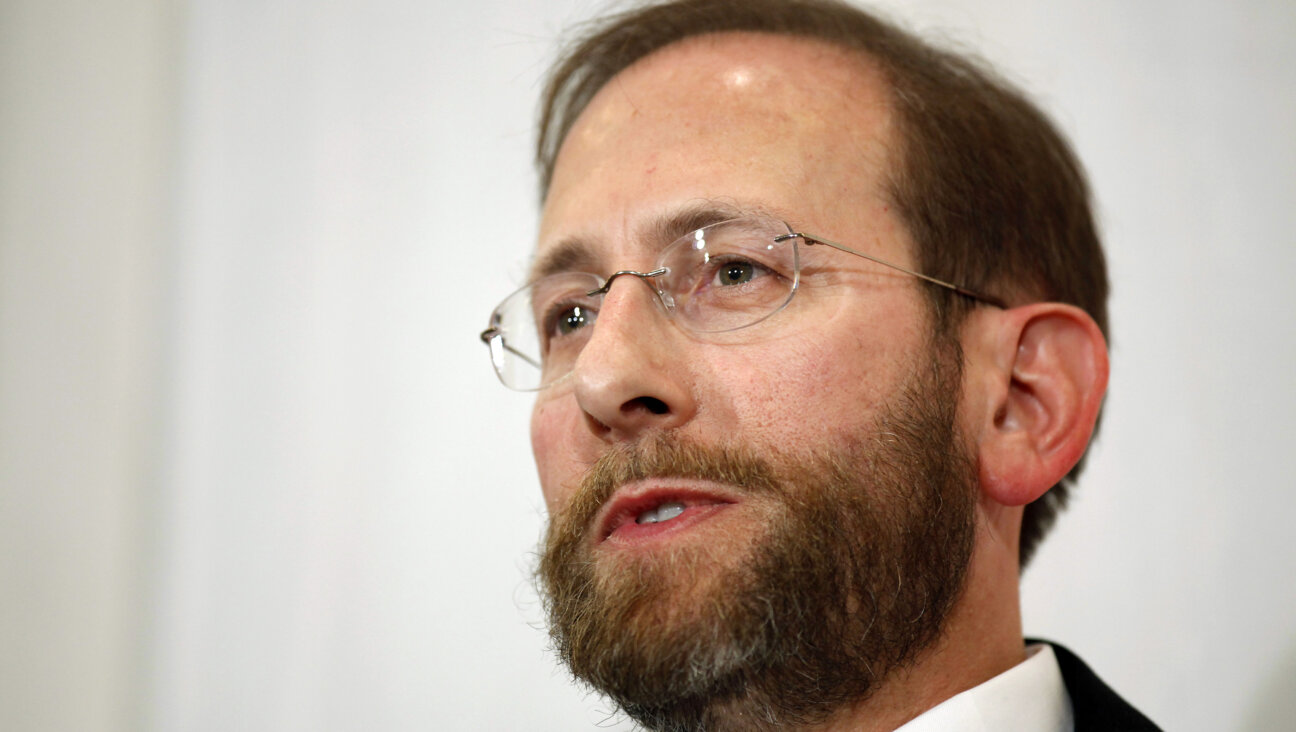As a Budget Storm Gathers, Bush Ignores Fiscal Forecasts
Ever since the Bush administration came to office in January 2001, it has repeatedly expressed overly optimistic views of the future. No sooner are the sunny pronouncements out of their mouths, it seems, that disaster strikes.
This may be the first president who bases the defense for his performance on all the bad things that have happened on his watch. The White House argument seems to be that it is doing surprisingly well — once you take into account the 2001 recession, the September 11 terrorist attacks, the breaching of the levies in New Orleans and the quagmire in Iraq.
The common thread running through all of these disasters is the administration’s failure to consider in advance the downside contingencies of history. The same pattern, not so coincidentally, applies to President Bush’s economic policy, particularly the budget deficit.
From the beginning, the government forecasts of the budget have been predictably overly optimistic. Fiscal forecasting, to be sure, is as hard as forecasting the weather. But the bias has been so consistent that one must assume that the strategy was deliberate, so as to justify tax cuts.
In January 2001, the government forecasted that the fiscal surpluses that had been inherited from the preceding administration would continue as far as the eye could see. Among other reasons for this, their forecast of the future economic growth rate did not allow for the likelihood that someday there would be a recession and a consequent decline in tax revenues.
As luck would have it, the recession began two months later. The Clinton administration, by contrast, had erred on the conservative side and had built the possibility of future recession into its forecasts.
Already by August 2001, the Bush administration had given away so much money in tax cuts — without the positive effect on growth and revenues that had been predicted by supply-side economics materializing — that professional forecasts showed that the surpluses were about to disappear.
But most of the public had yet to notice, and soon enough came the September 11 terrorist attacks. The White House was able to give Americans the impression that this tragedy was the source of the renewed budget deficits. Never mind that that the lost growth and tax revenue pre-dated September 11 rather than following it.
Meanwhile, spending increased rapidly. Bush argued that the government needed to spend more to make us safe from terrorism. Never mind that he accelerated the growth rate of government spending in such domestic areas as farm subsidies as much as in security-related spending. Never mind that pork spending, hidden under the name of Homeland Security, has disproportionately benefited Republican stronghold states like Wyoming rather than terrorist targets like New York. Never mind that the military effort in Iraq has made us less safe rather than more.
Most of the post-September 11 budget forecasts, short term as well as long term, have been as overly optimistic as the original ones, the one exception being the 2004 projection for what would happen in 2005. The forecasts haven’t allowed for realistic projections of spending growth, nor for the costs of the continuing engagement in Iraq, nor for the ever-more-extensive tax cuts that the administration continues to propose, nor for the agreed need to fix the Alternative Minimum Tax.
Now, we have on top of those sources of underestimates, the hundreds of billions of dollars to be spent atoning for the failures to prepare for, or deal promptly with, the consequences of Katrina. It should be clear by now even to the White House forecasters that the budget deficits are not going away anytime soon. Yet they are still at it.
The current forecast from the Office of Management and Budget is that the budget deficit will fall to $268 billion, or 2.1% of GDP, in 2006. But this won’t happen, nor will it decline by half within five years, as the president pledged in the 2004 campaign. At least the Congressional Budget Office’s forecasts finally contain the admission that the deficit will not disappear within 10 years, on current policies, even when the surplus in the Social Security trust funds is added in with the on-budget deficit.
Few people would disagree with the desirability of fiscal discipline: if budget deficits remain large in the long run, they can be harmful to the economy because they soak up available saving. But there is sharp disagreement about how to reduce American federal deficits. There are two competing views of political economy.
“Starve the Beast” hypothesis was proclaimed by some in the Reagan administration, after its tax cuts led to the emergence of record deficits. This proposition justifies tax cuts and budget deficits as a deliberate strategy to force Congress to cut spending. It is said that the government can’t spend money it doesn’t have. Many defenders of current administration policy have advanced this claim again today.
The alternative hypothesis could be called the approach of “Shared Sacrifice.” It says the way to achieve budget balance is a regime where each faction agrees to restrain itself simultaneously. Congressmen each agree to forego their individual pet tax cuts and spending programs if the others do.
This is the regime that was institutionalized in the Budget Enforcement Act negotiated by the first President Bush in 1990. The regime was renewed by the Clinton budget of 1993. Legislated spending caps and rules said that anyone proposing new tax cuts would have to show how to pay for them.
The graph to the left suggests pretty strongly that the “Starve the Beast” hypothesis is wrong: The budget deficits produced by the low-tax policies of 1981, 1989 and 2001 were accompanied by increased spending, not by reduced spending. The fact is that Congress can spend money it does not have, and does so gleefully.
Only after presidents have reversed their low-tax campaign platforms has progress been made in cutting both government spending and the deficit. In the 1990s, taxes were raised and at the same time spending was cut as a share of GDP. It worked. By the end of the Clinton administration, surpluses were back for the first time in 30 years. In fact, they reached record levels.
George W. Bush followed his two Republican predecessors in beginning his term with aggressive low-tax policies, and rapid increases in spending. But the administrations of Ronald Reagan and George H.W. Bush at least had the ability to perceive when the sky began to cloud over.
When fiscal reality began to deviate from the sunny scripts that had been written by their speechwriters, they made midcourse adjustments. Both presidents reversed themselves, and began to raise taxes soon after large deficits, which had been predicted by the pessimists, in fact emerged. The elder Bush deserved a medal for bravery for abandoning his “no new taxes” pledge, and he of course paid a heavy price electorally.
What is remarkable about his son is that there appears to be no feed-back loop from reality, no means of perceiving that things are not going as planned and that some sort of adjustment is called for. This management failure is a familiar story from Iraq policy, but it is equally true of fiscal policy.
The administration is still proposing tax cuts, perhaps still clinging to the “Starve the Beast” theory, even though it is at the same time raising spending as rapidly as ever. This is why an unbiased forecast shows widening budget deficits over the next 10 years.
Why should we fear these budget deficits? It is true that so far the financial markets have tolerated them remarkably well. But someday soon, the bond market will catch up with reality, and will fall substantially.
Rising long-term interest rates, not to mention slackening house prices, will send millions of American households into default on their mortgages — especially those with interest-only or Adjustable Rate Mortgages. Or perhaps a different shock will hit first: Foreign investors will tire of holding ever-greater amounts of dollar securities to fund America’s current account deficit. In that case, the dollar will fall, interest rates again will rise, and we may be back to stagflation.
We no longer will have the luxury of cutting taxes and interest rates as we go into the recession, as the government was able to do in 2001 because it had inherited low inflation and a strong budget after the long boom of the 1990s. Rather, we will have to raise interest rates and taxes, as budget deficits and inflation forced the government to do after the booms of the 1960s, ’70s and ’80s.
The president may marvel that no one could have foreseen such things. But risks such as financial bubble-burstings, recessions, terrorist attacks, oil price increases and hurricanes need to be planned for ahead of time. The less adequate the forward planning for disaster contingencies, the bigger the cost of cleaning up the mess on the day after.
The Forward is free to read, but it isn’t free to produce

I hope you appreciated this article. Before you go, I’d like to ask you to please support the Forward.
Now more than ever, American Jews need independent news they can trust, with reporting driven by truth, not ideology. We serve you, not any ideological agenda.
At a time when other newsrooms are closing or cutting back, the Forward has removed its paywall and invested additional resources to report on the ground from Israel and around the U.S. on the impact of the war, rising antisemitism and polarized discourse.
This is a great time to support independent Jewish journalism you rely on. Make a gift today!
— Rachel Fishman Feddersen, Publisher and CEO
Support our mission to tell the Jewish story fully and fairly.
Most Popular
- 1

Opinion The dangerous Nazi legend behind Trump’s ruthless grab for power
- 2

Culture Trump wants to honor Hannah Arendt in a ‘Garden of American Heroes.’ Is this a joke?
- 3

Opinion A Holocaust perpetrator was just celebrated on US soil. I think I know why no one objected.
- 4

Culture Did this Jewish literary titan have the right idea about Harry Potter and J.K. Rowling after all?
In Case You Missed It
-

Culture I have seen the future of America — in a pastrami sandwich in Queens
-

Culture Trump wants to honor Hannah Arendt in a ‘Garden of American Heroes.’ Is this a joke?
-

Opinion Gaza and Trump have left the Jewish community at war with itself — and me with a bad case of alienation
-

Fast Forward Trump administration restores student visas, but impact on pro-Palestinian protesters is unclear
-
Shop the Forward Store
100% of profits support our journalism
Republish This Story
Please read before republishing
We’re happy to make this story available to republish for free, unless it originated with JTA, Haaretz or another publication (as indicated on the article) and as long as you follow our guidelines.
You must comply with the following:
- Credit the Forward
- Retain our pixel
- Preserve our canonical link in Google search
- Add a noindex tag in Google search
See our full guidelines for more information, and this guide for detail about canonical URLs.
To republish, copy the HTML by clicking on the yellow button to the right; it includes our tracking pixel, all paragraph styles and hyperlinks, the author byline and credit to the Forward. It does not include images; to avoid copyright violations, you must add them manually, following our guidelines. Please email us at [email protected], subject line “republish,” with any questions or to let us know what stories you’re picking up.















